Click for more on my travels in North Korea, Iraq, and Iran. |
Book Now Available! |
Panmunjom: Visiting
the Korean DMZ |
|||||||
Having written about a visit to the DMZ and Panmunjom from the North (Journey into Kimland) I figured it was time to try writing something about the far more popular visits from the South. There are already numerous resources on the Net providing specific tour info (more on that below) so what I'm going to focus on here is providing some general background and a comparison of my impressions with those of others, for example, the recent article on the DMZ in National Geographic. First though, tour info. For those of you looking to take a tour of Panmunjom and the DMZ from the South I would mainly recommend the USO in Seoul at http://uso.org/Korea/. You could also try the Panmunjom Travel Center at http://panmunjomtour.com. Please keep in mind that the South Korean government does not currently allow its citizens to visit Panmunjom without prior government approval. For those looking to visit from the North I would suggest DPRKorea Infobank at http://dprkorea.com/ or Koryo Tours at http://koryogroup.com/. Please keep in mind that it is normally extremely difficult, if not impossible, for U.S. passport holders to get North Korean tourist visas. |
|||||||
Click for more on my travels in North Korea, Iraq, and Iran. |
Book Now Available! |
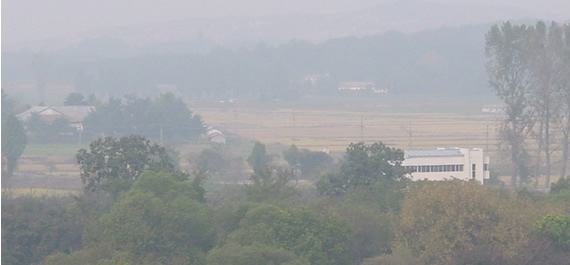 View into North Korea from Panmunjom |
|||||||
Now, on to the traveling. Most articles I've read on the DMZ tend to focus on the danger and the militaristic aspects of the place. It seems that without fail you're going to get these three comments in every article:
No arguments here - it is a dangerous, militarized place. There are a lot of soldiers along the border. But a couple of these comments can be misleading and seem designed more to heighten interest or sell stories than to portray the reality of the ongoing confrontation at the DMZ. |
|||||||
First off, why wouldn't the vast majority of North Korean soldiers be along the border with the South? Given that their other two borders are with traditional allies China and Russia the more interesting fact would seem to be that at any given time North Korea deploys a 25-35% of it forces outside it's main threat area. The U.S. isn't going to withdraw a third of its troops from the DMZ to defend the Canadian border, so why does North Korea keep a similar portion of its forces away from the South? The short answer is two-fold. First, they need to keep troops along the border with China and Russia to prevent starving North Koreans from escaping and exacerbating a refugee crisis that is beginning to irritate its two main allies. Second, they are forced to use a large number of military personnel to run state-controlled farms and factories in an effort to ensure and stabilize output. Pertinent info generally left out of most DMZ stories. |
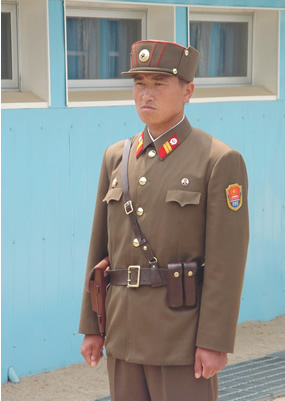 Close-up of North Korean soldier Photo courtesy Thomas St. John |
||||||
The other main point that is often glossed over, geographically, is how small North Korea really is. Most articles somewhat ominously mention the huge percentage of North Korean troops deployed within a few hours of the border. In the recent National Geographic article mentioned above there's a quote about how 70% of North Korean soldiers are deployed within 12 hours of the border. 12 hours! Really?!? I've ridden, on a bus, from the DMZ to the North's Mt. Myohyang in less than six hours. That mountain is easily two-thirds of the way from the DMZ to the Chinese border - meaning I could have traversed the whole country, south to north, in less than 10 hours. The fact that 70% of their forces are within 12 hours is not what is surprising - what is surprising is how they've gotten 30% of their soldiers more than 12 hours from the border! The North, the DMZ and the potential for nightmarish problems are real enough as is - there's no need to jazz things up to heighten the threat or sell stories. The next time you see a report on the DMZ or confrontation at the border please see how many of the above points the reporter includes. Whew, with that off my chest let's get back to traveling. |
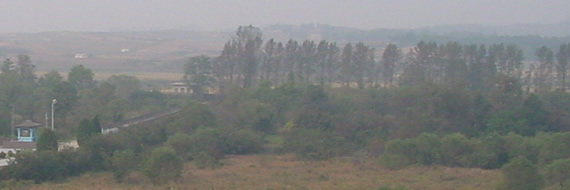 The blue building on the left is in South Korea, the white building is in the North - in between is The Bridge of No Return |
|||||||
The one thing that never fails to surprise me when I visit the DMZ is the utter peacefulness. From all the media reports describing it as 'the world's most heavily defended border', you would never expect a quiet countryside full of farms and small forests. But that's usually exactly what you get. I say usually here because the stillness is occasionally shattered when one side blasts propaganda at the other. But if you're lucky enough to be there when the loudspeakers fall silent, the place really can seem eerily quiet. Troops are mainly kept just outside of the DMZ, hence the term De-Militarized Zone. This is on both sides of the four kilometer (about 2.5 mile) wide band stretching across the entire width of the Korean peninsula. A band of emptiness that has made the DMZ itself, landmines or not, such a haven for wildlife that South Korean environmentalists are calling upon both governments to preserve the area as a national park after reunification. It seems that 50 years without any people has turned the place into one of the best wildlife refuges in East Asia. Even the approaches to the DMZ seem relatively normal on each side. In the North it's mainly the same empty countryside one sees outside of Pyongyang, while in the South it's busy small towns interspersed with quiet fields of rice paddies. The main clue in the South that you're nearing the border is the occasional narrowing of the road as it goes under a large block of concrete. If you look carefully as you go past you can see the supports for the concrete are designed to be blasted out of the way, dropping the blocks across the road and hopefully slowing any North Korean advance on Seoul. Most tours of the DMZ, from Pyongyang or Seoul, will take you to the most historically interesting part of the dividing line, the Joint Security Area (JSA), also called 'Panmunjom' (here the 'pan' is pronounced like the 'pon' in pond, the 'mun' like moon, and the 'jom' like, well, 'jawm'). The JSA/Panmunjom is what most people are referring to when they talk of visiting the DMZ. This area was the home of the negotiations that finally halted the Korean War in 1953, and since then it has been used for all types of negotiations between the North and South, the North and U.S., and the North and UN. If you see news coverage of meetings occuring in the DMZ this is the place - on the tours you'll even get to visit the same building used by the negotiating teams. Upon nearing the JSA tours from both the North and South are remarkably similar. First you're warned by your guides of how dangerous the area is - this is the kind of place where a firefight really could break out at any moment. Both sides begin with a briefing provided by one of the soldiers stationed in the DMZ. From the South the English briefing is generally conducted by one of the U.S. soldiers stationed in the area. He (the DMZ is a relatively woman-less place) will run through the history of the JSA and provide you with a description and photos of the buildings in the area, both North and South. After that it's back on the bus for the short trip north into the heart of the JSA. The North conducts a similar briefing, only in Korean while your guides translate. The North has a large topographical model of the area that a soldier uses to point out the various buildings and features, while also giving you background on how the JSA came to be. Once the short briefing is over (they both take about 10-15 minutes, depending on questions) it's back on the bus for the short drive south into the heart of the JSA. Take a look at the North's topographical model in the picture below for an overview of the JSA and surrounding area. |
|||||||
|
|||||||
| Upon entering the JSA both sides take you into the heart of the complex - two large buildings overlooking the actual border line and the row of buildings that evenly straddle it. The buildings are facing each other in the photos below. | |||||||
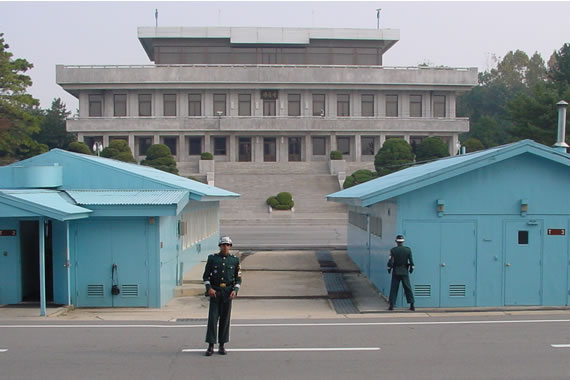 From the South looking north - the soldiers are South Korean border guards, the border runs between the two buildings - it's the line in the center |
|||||||
|
|||||||
| The pictures here were taken months apart while standing in directly opposite positions. Unfortunately you can't just walk over the border (without getting shot anyway), basically the only way from one side to the other is via China. In both pictures I'm about 50 miles (80 kilometers) from my home in downtown Seoul. One trip took me two hours to get back, the other, three days. | |||||||
Notice how each photo above shows an open door into the same center blue building. This is where most meetings between the UN/US and North Korea are held. It's also one of the highlights of the trip. Each side allows you to enter the building and look around. As the building itself is half in the North and half in the South, once inside you are in reality moving freely between North and South Korea. Since the war ended in 1953 this has been the only place on the peninsula where that's been possible. Inside the building, a large conference table goes across the exact center. Down the exact center of the table is a microphone cord that, in essence, tells you right where the border runs through the room. Interestingly, on the North Korean trip you're free to wander the room at will, whereas on the trip from the South a guard stands at one end of the conference table, the end nearest the UN flag, and prevents you from passing on his side. Everyone is forced to cram themselves around the opposite end of the table to get to the other side of the room/border. I've never been able to figure out why this is . . . In case you're wondering - soldiers always block the opposite side's door to prevent anyone from defecting. |
|
||||||
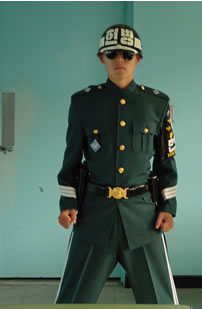 South Korean soldier guarding the door to the North |
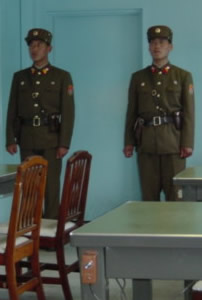 Two North Korean soldiers guarding the door to the South Photo courtesy Dan Harmon |
||||||
| In the South, after touring the conference room, you're taken to a small pagoda overlooking the heart of the JSA. It makes for great pictures and a chance to get more of a bird's eye view of the layout. It also affords you a bit of an angle to examine the North's building. | |||||||
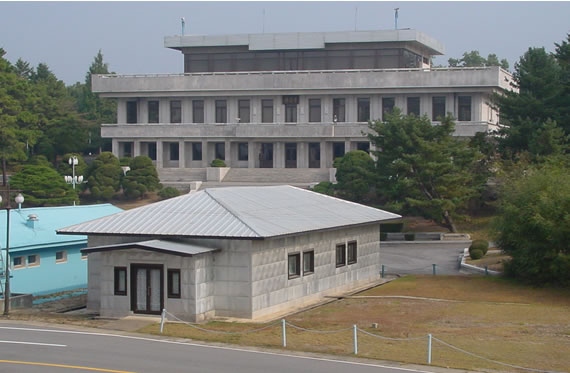 Side view of the North's main building in the JSA |
|||||||
What's the big deal with the side view? Well, for years the U.S. military was telling unsuspecting tourists that the North's building was really just a facade. That there really wasn't a building at all - just the front of a building with nothing behind it. At the time your only view was dead-center from the front, like in the picture from the South looking north, above. An angle from which it's impossible to judge the depth of the building. Since the new building went up a few years ago however, the viewing pagoda was moved to the right and these side views into the North became possible. Since then the "just a facade" story seems to have faded away. When I related this story to my guides in the North, while standing in their "facade" building, I nearly got into a fight when one of them became incensed at "the lies of the Americans." More info on that can be found on the DMZ pages of my trip to the North. |
|||||||
In the North, once you've toured the conference room, you're led onto the verandah of their building to take some more pictures and get one last look at the South. After that you get a chance to visit the room where the actual armistice treaty halting the Korean War was signed. It's too bad this building isn't halfway in the South as well - careful preservation has kept the area emanating history. Sitting in that room it's like the 50-year-old treaty was just signed a few weeks ago. After the armistice room comes a quick visit to a small museum where the North presents its viewpoint on the outbreak of the Korean War and what has taken place since. After the museum it's back on the tour bus for the trip north out of the DMZ. As for the tour from the South - once you've toured the conference room it's off to a small hill overlooking the Bridge of No Return (see pictures above and below). Then, back on the bus, you're driven past the infamous 'Ax Incident' tree and right up to the South's side of the bridge. |
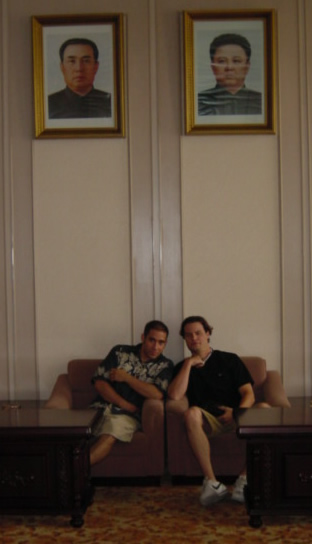 Inside the North's main building in the JSA - Pictures of Kim Il-sung and his son Kim Jong-il dominate the room, as they do nearly every other important place in North Korea. Photo courtesy Thomas St. John |
||||||
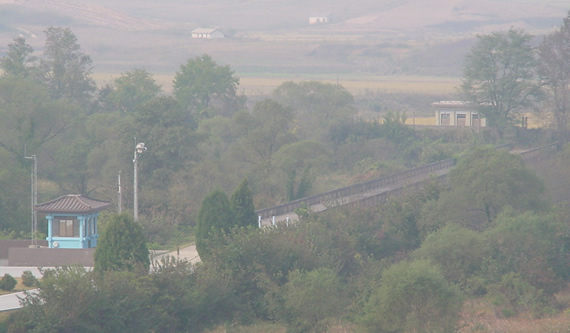 Bridge of No Return - for over 50 years the only way across the DMZ |
|||||||
You're not allowed off the bus near the Bridge, the picture here to the right was taken through the bus window. Just to the right of the picture is a small memorial to those who died in the "Ax Incident". The incident occurred in August, 1976 when a group of American soldiers attempted to cut down a tree blocking their view of the Bridge from the hill above. At the time forces from both sides were free to go anywhere in the JSA - back and forth across the actual border. A group of North Koreans set upon the Americans, took the ax they were using on the tree and beat two of them to death. In the North you can actually see the "military ax" on display in the JSA museum. For more on the Ax Incident from those who were there click here. After a brief pause for pictures the bus then heads south out of the JSA and back down to Seoul. |
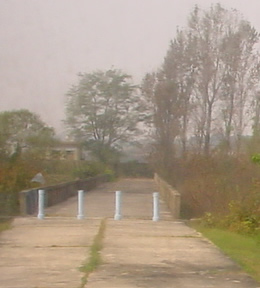 View into the North across the Bridge of No Return |
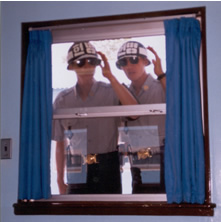 SK soldiers checking us out. Photo courtesy Thomas St. John |
One of the more interesting parts of both trips is how much the other side stares at you. On the visit from the North the South Korean soldiers (no American soldiers were visible at the time) monitor everyone quite closely. They take pictures, scan with binoculars and come right up to the windows of the conference room to look inside, as in the picture to the left. On trips from the South you get similar treatment from the North's soldiers. They'll come down and look through the windows, plus monitor your group from the guard post, shown below. |
||||||
The guard post shown here is just to the right of the main North Korean building overlooking the DMZ. During the tour, if you look carefully, you should be able to see yourself being watched and photographed by NK soldiers. The whole scene, on both trips, is one of cautious tension. No one wants to look weak or back down, but no one wants to start a war either. There's plenty of staring, but no communicating on a personal level, between the two sides. Usually, the only sounds are those of the tourists, guides and a few birds. Though this isn't always the case - at times the sides blast propaganda at one-another. Variously done to encourage defections, denigrate the other side, or just be irritating, it's supposed to have died down recently from the levels of decades past. |
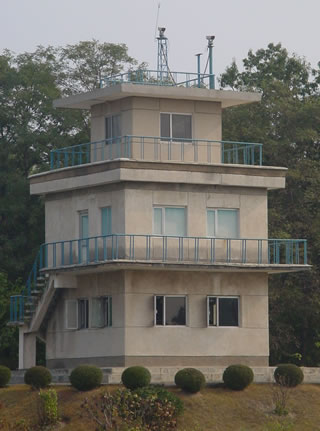 North Korean guard post overlooking JSA |
||||||
Surprisingly, unlike what was written in the National Geographic story, there have been defections by U.S. soldiers to the North. On page 12 their story mentions that "there have been no takers," for the North's efforts to lure defectors. Back in the 1960s and 70s however there were reports of U.S. soldiers defecting to the North. Some of them were later seen in North Korean movies - ironically mainly playing roles as "evil U.S. soldiers." Other reports tell of a U.S. defector who went on to marry a Japanese woman who had been kidnapped by the North in order to train NK spies in the finer points of Japanese language and culture. As part of the agreements surrounding Japanese Prime Minister Koizumi's visit to North Korea in 2002 that woman and several other Japanese kidnapees were allowed to return to Japan, though without any members of the families they had formed in North Korea. Some members of the Japanese press were then able to get an interview with this Japanese woman's GI husband (Sgt. Charles Jenkins) in Pyongyang. When asked if he wanted to join his wife in Japan the former soldier demurred, citing worries about prosecution for desertion by U.S. military authorities should he leave the North. Certainly one of the odder recent stories to come out of the DMZ . . . (UPDATE - Jenkins was later released, along with the couple's children, and currently lives in Japan) For more information on the DMZ, JSA, tours to the Koreas, etc. please try some of the links below:
|
|
Copyright 1999-2006 1stopKorea
|
|||||||